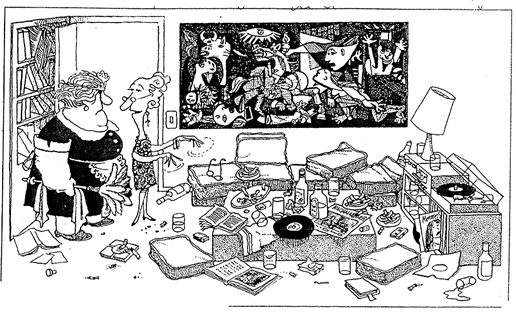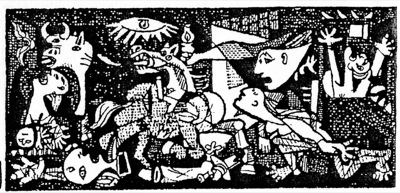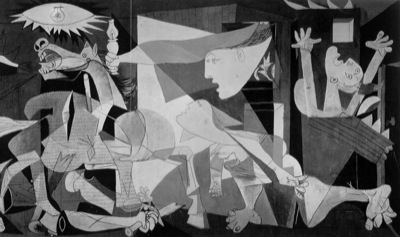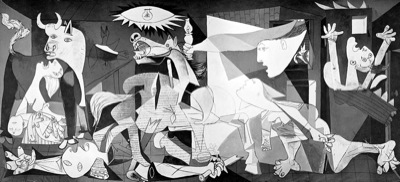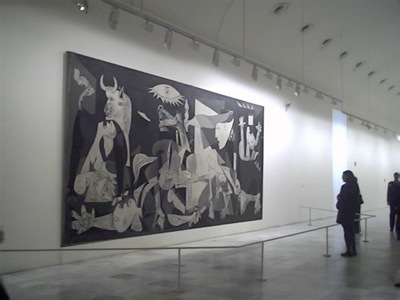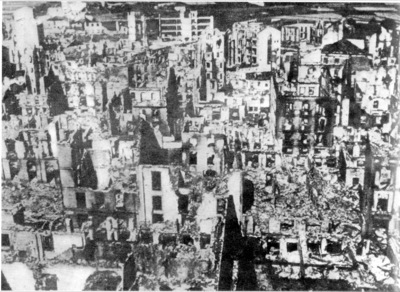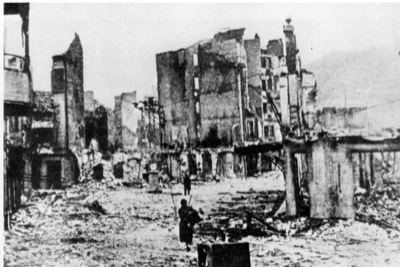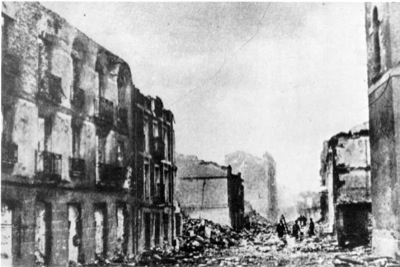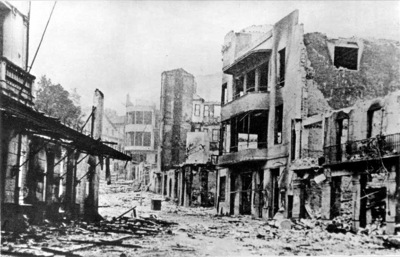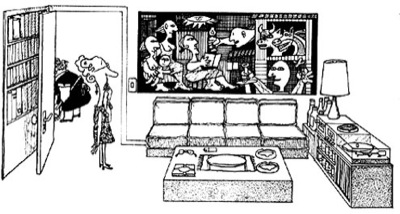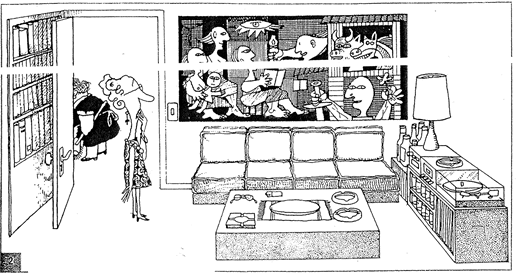Quino Cartoon, Picasso's Guernica, Guernica Historical Photos: Discussion
| Teacher Mark's ESL Oral English Lessons
In this lesson, we will look at a two-part cartoon by Quino, a well-known Argentine cartoonist. Quino is the pen name of Joaquín Salvador Lavado (born 17 July 1932). He is most famous for his comic strip Mafalda (1964 - 1973), which is about a young girl from Argentina. Mafalda, even though she is young in age, is a keen observer of her society and humans in general.
Check out this gallery of the main images.
Scene one
Scene 1: Describe the scene: Where are they? Who are these people? What do they look like? What happened before?
Painting in Background:
This is a cartoon version of a very famous painting. What painting is this? Who painted it? Why did he or she paint it? What was the event the provoked the artist to paint this?
Picasso's Guernica:
Guernica is a painting by Pablo Picasso (b. October 25, 1881, d. April 8, 1973), inspired by Picasso's horror at the Nazi German bombing of Guernica, Spain on April 26, 1937 during the Spanish Civil War. Guernica depicts suffering people, animals, and buildings wrenched by violence and chaos.
The painting is currently located in the Museo Reina Sofía or Queen Sofia Museum in Madrid, Spain. The huge mural was produced under a commission by the Spanish Republican government to decorate the Spanish Pavilion at the Paris International Exposition (the 1937 World's Fair in Paris).
The mural presents a scene of death, violence, brutality, suffering, and helplessness without portraying their immediate causes. The choice to paint in black and white contrasts with the intensity of the scene depicted and invokes the immediacy of a newspaper photograph.
Quote from Picasso about Guernica:
"The Spanish struggle is the fight of reaction against the people, against freedom. My whole life as an artist has been nothing more than a continuous struggle against reaction and the death of art. How could anybody think for a moment that I could be in agreement with reaction and death? ... In the panel on which I am working, which I shall call Guernica, and in all my recent works of art, I clearly express my abhorrence of the military caste which has sunk Spain in an ocean of pain and death."
Sizee of Guernica:
It is eleven-and-one-half-foot tall and almost twenty-six feet wide mural painted in oil (or 3.5 m X 8 m).
SIZE OF Guernica:
The event that inspired Picasso's painting occured on on April 26, 1937 during the Spanish Civil War in the city of Guernica. The Nazi German airforce bombed the city destroying the numerous buildings, killing an estimated 1,600 people and injuring many more.
Another Look at Scene One:
What do you think will happen next?
Scene Two:
What happened? Describe the Scene. What changed from before? How are the two scenes different?
What is the cartoonist's message?
Meaning of These Cartoons
Teacher Mark's Personal Interpretation
In this two-panel cartoon with the caption on est né comme on est né (lit. "we are born as we are born" or "who we are is determined by where we come from") by the Argentine cartoonist Quino, we see a woman’s living room change completely from messy and disorderly to pristine and well-organized.
In the first panel, there are two women—the one to the right is a fat, cubby-faced, working-class maid or cleaning woman while the second, who is clearly the owner of this apartment or house, is thin and bourgeois. The bourgeois woman motions to the portly cleaning woman to clean the mess up. This living room is a disaster area with overturned bottles, overflowing ashtrays and cigarette butts, empty glasses, scattered books, records, and cassettes. While this first panel clearly displays the remnants of riotous party, there are a few clues that hint at the kind of people this place is associated with, namely pretentious bourgeoisie. First, the thin woman wearing a flower dress who carries all the markings of being high-class and rich. Second, the record jacket on the coffee table by Rachmaninoff, a Russian composer, who is considered ‘great’ by a certain elitist, artistic taste but is completely unknown to popular masses. Third and most importantly, there is a representation of a painting by Pablo Picasso called Guernica. This Cubist painting, painted in stark black, white, and grey, recounts the massacre of a Spanish village during the Spanish Civil War by the German air force. In the picture, we see the remains and debris of war—scattered limbs, a woman holding her dead baby, tearful eyes, and arms raised in exasperation to the sky—as well as mutated symbols of Spain including a bull and a horse in pangs of anguish. While this painting is well-known the world over, it is part of certain kind of elitist and pretentious canon of things ‘you just must know.’ These elements combine to reveal a very bourgeois, elitist, pretentious background to this messy room. In the second panel, Quino shows the room completely cleaned as well as a shocked, bourgeois woman looking on. All of the physical untidiness has been removed, and everything has been reorganized and cleaned, as was expected, but what shocks the woman is that the painting too has been tidied up and cleaned. Instead of the tortured scenes of war and destruction, we see a happy, reconciled world where everyone is both alive and smiling. The practical cleaning woman, while cleaning the rest of the room, also cleaned up this image.
Considering the caption on est né comme on est né what does this cartoon mean? In my opinion, this cartoon is a political piece critiquing how the rich elite live. While the rich often live with a high sense of artistic taste, there seems to be, according to this cartoon, a sheer lack of understanding about action and change. The working-class cleaning woman does not see the artistic wonder of this painting; she sees a practical problem, namely this mess, and thus she cleans the painting up just like the rest of the room. The bourgeois woman is shocked by the change, because she never saw it as a mess but as art.
